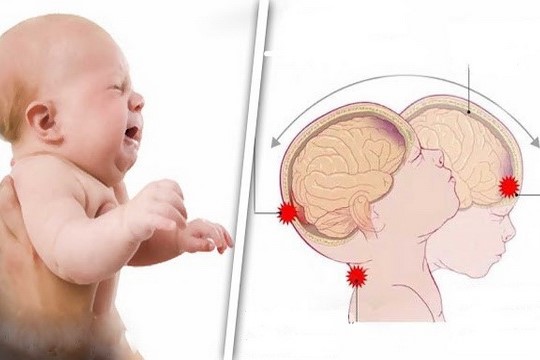
Shaken baby syndrome: the very serious damage of violence on the newborn child
Shaken baby syndrome (also called by the acronym SBS, or abusive head trauma or shaken baby syndrome) is a very serious form of physical abuse, mainly – but not exclusively – intra-familial abuse of children generally under one year of age (infants and young children)
Causes of Shaken Baby Syndrome SBS
The causes of SBS are the rapid and violent shaking of the child, which generally occurs over a period of 10-20 seconds.
The baby is shaken violently by the caregiver, usually the father, mother, grandparent or guardian, as an exaggerated reaction to the baby’s inconsolable crying.
The peak incidence of SBS occurs between 2 weeks and 6 months of age, the period of maximum intensity of infant crying.
At that age a shaking movement is particularly dangerous, because
- the baby does not have full control of its head;
- the baby’s neck muscles are weak;
- the baby’s head is heavy in relation to the body;
- the baby’s brain is of a gelatinous consistency and moves strongly in the skull when the head is shaken;
- the bone structure is still fragile.
Parents in the first months of a baby’s life, and particularly in the case of a first-born child, are subjected to great stress and sleepless nights that can lead to such exasperation that – at the umpteenth cry – they cause totally irrational reactions, such as shaking the baby violently.
A risk factor that can trigger violent and irrational behaviour towards a newborn child is post-partum depression.
CHILD HEALTH: LEARN MORE ABOUT MEDICHILD BY VISITING THE BOOTH AT EMERGENCY EXPO
Consequences for the baby of SBS
The consequences of shaking can unfortunately be particularly inauspicious, especially at the nerve level, and are similar (and often worse) to those that can occur in a rear-end car accident: subdural or subarachnoid intracranial haemorrhages, brain contusions and direct nerve fibre lesions are fairly typical events and can lead to brain death of the baby.
Shaking causes a mechanical damaging action related to the abrupt accelerations and decelerations to which the encephalon, cerebral vessels and more generally all tissues are subjected, which – in simple terms – literally slam against the skull back and forth.
The forces generated by the shaking can cause the brain’s white matter axons to stretch and sometimes completely rupture.
The shaking can easily lead to permanent neurological damage with even very severe motor and/or sensory deficits such as paralysis, slowed psycho-motor acquisition, cognitive-behavioural deficits, deafness, retinal haemorrhages, often resulting in central blindness, multiple fractures, mostly of the skull (if there is also impact on the surface), long bones and posterior portion of the ribs.
This can lead to coma or death of the child in one out of four cases.
Shaken baby syndrome: “So much damage from one shake?”
Certainly yes: even a fairly weak and short-lasting shake, which is harmless in an adult, can have disastrous effects on the baby, and it is not by chance that one of the most important precautions in the first months of life is precisely to prevent the baby’s head from being supported.
Some peculiar anatomical features of newborns and infants favour the occurrence of the biomechanical damage already described: fundamental is the considerable volume and weight of the head in relation to the rest of the body mass, the hypotonia of the cervical paraspinal musculature (which causes the typical ‘dangling’ of the head in the first months of life), the high water content of the immature central nervous system, the incomplete myelination of the nerve fibres and the high volume of the subarachnoid spaces compared to the still modest brain volume.
Diagnosis of SBS
Tracing certain lesions to the syndrome may not be entirely easy: they can often be confused with lesions caused by trauma during play.
A thorough investigation by the paediatrician, forensic scientist and law enforcement is always necessary.
Retinal haemorrhages can also potentially be diagnosed with MRI.
Variants of Shaken Baby Syndrome
The Anglo-Saxon term ‘Shaken impact syndrome’ denotes a variant of ‘shaken baby syndrome’, in which the child is not simply shaken furiously, but is thrown violently against a fixed surface, not necessarily hard and rigid, such as a bed.
Read Also:
Emergency Live Even More…Live: Download The New Free App Of Your Newspaper For IOS And Android
Pain Management In The Paediatric Patient: How To Approach The Injured Or Aching Children?
Pericarditis In Children: Peculiarities And Differences From That Of Adults
In-Hospital Cardiac Arrest: Mechanical Chest Compression Devices May Improve Patient Outcome
Stress And Distress During Pregnancy: How To Protect Both Mother And Child
Chronic Pain And Psychotherapy: The ACT Model Is Most Effective
Paediatrics, What Is PANDAS? Causes, Characteristics, Diagnosis And Treatment
Pain Perception In Children: Analgesic Therapy In Paediatrics
Obstructive Sleep Apnoea: What It Is And How To Treat It
Obstructive Sleep Apnoea: Symptoms And Treatment For Obstructive Sleep Apnoea
Our respiratory system: a virtual tour inside our body
Tracheostomy during intubation in COVID-19 patients: a survey on current clinical practice
FDA approves Recarbio to treat hospital-acquired and ventilator-associated bacterial pneumonia
Clinical Review: Acute Respiratory Distress Syndrome
Stress And Distress During Pregnancy: How To Protect Both Mother And Child
Respiratory Distress: What Are The Signs Of Respiratory Distress In Newborns?
Acute Hepatitis Cases In Children: Learning About Viral Hepatitis


